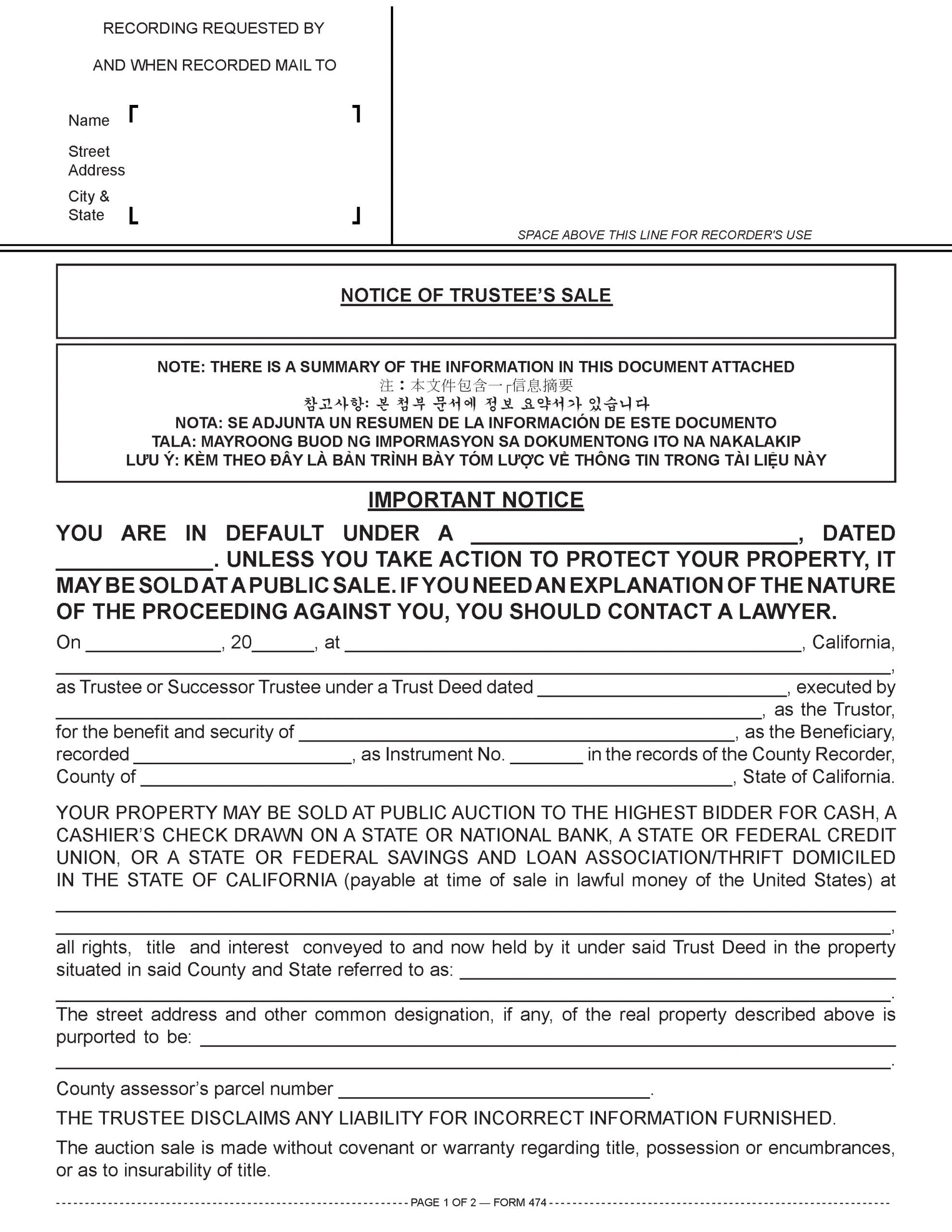Nonjudicial foreclosure
A trust deed is a security device which imposes a lien on real estate. [See RPI e-book Real Estate Principles Chapter 69]
A trust deed has three parties:
- at least one trustor (the owner(s) of the secured real estate);
- a trustee (one who holds title to the real estate in trust for another); and
- at least one beneficiary (a lender, carryback seller, homeowners’ association (HOA) or another lienholder).
A nonjudicial foreclosure sale,
- named in the trust deed; or
- appointed by the beneficiary of the trust deed when the beneficiary initiates the foreclosure process.
The trustee begins foreclosure by recording a notice of default (NOD). [See RPI Form 412]
At least 30 days prior to recording an NOD on a trust deed securing a purchase-assist mortgage on a borrower’s principal residence, a mortgage holder needs to conduct a pre-foreclosure workout with the owner to explore options for the owner to avoid foreclosure and provide financial counseling to the owner. [See RPI e-book Real Estate Finance Chapter 44]
The key to the trust deed holder’s ability to nonjudicially foreclose by a trustee’s sale on the secured real estate is the power-of-sale provision contained in the trust deed. [See RPI Form 450 §3.6]
The nonjudicial foreclosure process has three stages:
- the NOD is recorded and mailed;
- the notice of trustee’s sale (NOTS) is recorded, posted and mailed [See RPI Form 474]; and
- the trustee’s sale of the real estate by auction.
Related Video: The Stages of Foreclosure, Reinstatement and Redemption
Click here for more information on this topic.
The NOD and the trustee’s sale guarantee
When a trust deed is in default and the beneficiary has chosen to foreclose, the beneficiary delivers a Declaration of Default and Demand for Sale to the trustee.
The declaration contains instructions directing the trustee to initiate foreclosure on the secured real estate as authorized under the power-of-sale provision contained in the trust deed.
Even though the trustee may have received the beneficiary’s declaration of default, the trustee’s foreclosure process and the periods imposing rights and obligations do not begin until the trustee or beneficiary records an NOD. [System Investment Corporation v. Union Bank (1971) 21 CA3d 137]
Once the NOD is recorded, the trustee is to strictly follow statutory notice requirements. To be assured the required notices are served on all the proper persons, the trustee orders a trustee’s sale guarantee from a title company before or at the time the NOD is recorded.
The trustee’s sale guarantee provides coverage to the trustee for failure to serve notices on any party due to an omission of that person’s identity in the guarantee.
The NOD and election to sell
When ordering a trustee’s sale guarantee from a title insurance company, the trustee instructs the title company to record the NOD in the office of the county recorder in the county where the real estate is located. [Calif. Civ. Code §2924]
The NOD contains statutorily mandated statements which sets forth the monetary default on the note or other obligations secured by the trust deed. [CC §2924c(b)(1)]
The NOD does not need to state the amounts of the monetary defaults on the recurring obligations. However, the NOD does need to state the nature of the present defaults on the mortgage. [CC §2924c(a)(1)(B); CC §2924c(a)(1)(C)]
To determine the amount needed to cure the default, the NOD directs the owner seeking to reinstate the trust deed or redeem the property to contact the trustee.
Thus, the trustee insulates the beneficiary from all direct contact with the owner or junior lienholder after the date the NOD is recorded until:
- the NOD is canceled; or
- a trustee’s sale takes place.
Related Video: The Notice of Default
Click here for more information on this topic.
Delivery of the NOD
Within 10 business days after recording the NOD, two copies of the NOD are mailed to:
- the owner of the property;
- the administrator of a deceased owner’s estate; and
- each person who has recorded a request to receive a copy of the NOD. [CC §2924b(b)(1)]
Within one month after recording the NOD, the trustee sends a copy of the NOD by registered or certified mail and another copy by first-class mail to holders of a recorded interest in the property.
Any person interested in obtaining a copy of the NOD who will not automatically receive the notice records a request for NOD. The request for NOD assures the interested person they will be notified of the default. [See RPI Form 412]
A trustee or person depositing the NOD into the mail to give notice to others prepares a proof of service and includes a copy of the form with the NOD in each mailing. [CC §2924b(e)]
Further, when the mortgage secured by the trust deed was originally negotiated in one of five languages other than English, the trustee is obligated to serve the owner an NOD translated into that language. These languages are:
- Chinese;
- Korean;
- Spanish;
- Tagalog; or
- Vietnamese. [CC §2923.3(a); See RPI Form 471-2 through 471-6]
An escrow officer, lender or carryback seller uses the Request for Notice of Default and Notice of Delinquency – By Junior Trust Deed Beneficiary form published by Realty Publications, Inc. (RPI) when recording a junior trust deed or a change of address. It allows the escrow officer, lender or carryback seller to request a senior lienholder to send the junior lienholder a copy of any NOD the senior lienholder may record and a notice of delinquency (NODq) on a default of payments owed to the senior lienholder. [See RPI Form 412]
The notice of trustee’s sale
A trustee or beneficiary may begin noticing the date set for the sale of a property on the day following three months after the NOD is recorded. [CC §2924]
The trustee prepares an NOTS which contains:
- the trustee’s name or their agent’s name, street address and telephone number (or toll-free number when located out of state);
- the street address or common designation of the secured property;
- the county assessor’s parcel number of the secured property;
- the dollar amount of the debt in default, including reasonably estimated advances for hazard insurance premiums, property taxes due and foreclosure costs; and
- a statutory statement informing the owner they are in default. [CC §2924f; See RPI Form 474]
In general practice, a date down of the trustee’s sale guarantee issued to the trustee is ordered out from the title company the day before or on the day the title company records the NOTS.
The date down notifies the trustee of any interests recorded on the title to the property after the NOD is recorded. However, the trustee is not required to give notice of the impending trustee’s sale to any person who recorded an interest in the property after the NOD was recorded. [CC §2924b(c)(1)]
Related Video: The Notice of Trustee’s Sale
Click here for more information on this topic.
Delivery of the NOTS
At least 20 calendar days before the trustee’s sale, the trustee sends two copies of the NOTS to each party the trustee previously sent the NOD. [CC §2924b(c)(3)]
In addition to mailing the notice to all the interested parties of record, the trustee performs all the following steps at least 20 calendar days prior to the sale:
- posting a copy of the NOTS in one public place in the city of the sale, or when the sale is not held in a city, the judicial district in which the property is being sold;
- posting a copy of the NOTS in a conspicuous place on the property to be sold; and
- publishing a copy of the NOTS once a week for three consecutive calendar weeks in a newspaper of general circulation in the city where the property is located. [CC §2924f(b)(1)]
A trustee or beneficiary uses the Notice of Trustee’s Sale (NOTS) form published by RPI when notifying a delinquent owner or junior lienholder they are in default and that, unless they take action to protect their property, it may be sold at a public sale to the highest bidder. [See RPI Form 474]
Like the NOD, the NOTS needs to contain a summary of key information in the language the mortgage was originally negotiated in. [CC §2923.3; See RPI Form 474-3 through 474-7]
A trustee’s sale may be postponed by the trustee at any time prior to the completion of the foreclosure sale. The trustee’s sale may be postponed on the instruction of the mortgage holder or by the trustee at their discretion. [CC §2924g(c)(1)]
















